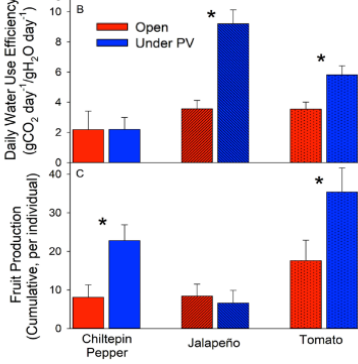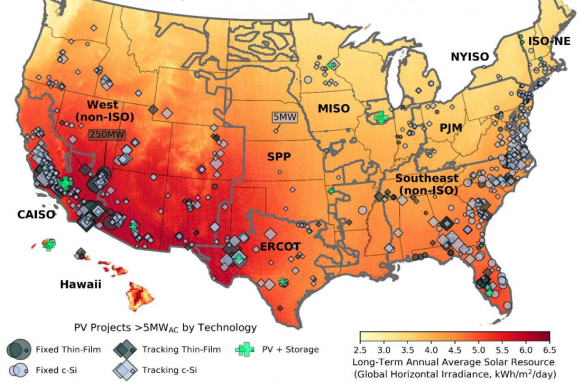US agri-PV teams build data for commercial roll-out
Developers and researchers are testing optimal crop and technology choices for combined agri-PV projects in a bid to cut costs and scale up capacity.

Related Articles
Interest in agri-PV (agrivoltaics) is rising as PV costs fall, competition for land resource mounts and climate fears grow.
Agri-PV is the simultaneous use of land for solar power and crop cultivation or pollinator habitats necessary for farming ecosystems.
Some farmers have ring-fenced land for stand-alone PV production to take advantage of higher revenue potential. Integrated agri-PV fields allow farmers to increase revenue per acre without trimming crop areas. The income from PV plants also helps to mitigate seasonal fluctuations in crop yields and prices.
Strategic PV panel placement can protect crops, increasing yields on a number of produce including fruits, vegetables, nuts, herbs and spices.
In one example, PV panels doubled the yields of tomatoes and chiltepin peppers at a site in Arizona, the National Renewable Energy Laboratory (NREL) said in a recent report. The PV panels also lengthened the growing season and lowered water consumption.
Crop yield boost from US agri-PV trials

Source: NREL's 'Co-Location of Agriculture and Solar' report (2019).
High-value, hand-harvested crops hold the greatest promise for agri-PV applications, Jordan Macknick, Lead Energy, Water and Land Analyst at the Strategic Energy Analysis Center at NREL, told Reuters Events.
“Solar infrastructure doesn’t disrupt their current methods of planting, maintenance and harvesting,” Macknick said.
The development of agri-PV has advanced more quickly in Europe due to greater pressures over land resources and more support from private and public entities, Greg Barron-Gafford, Associate Professor at the University of Arizona School of Geography and Development, said.
However, a range of US research projects are now underway and some solar developers are including dual-use projects in their portfolios.
These projects will need to tackle the cost premiums for installing and maintaining agri-PV ahead of wider commercial deployment.
US data
Solar panels can boost crop yield across various weather conditions by protecting plants from direct sunlight, rain, hail and frost, Barron-Gafford said.
These benefits will likely increase as climate change impacts weather systems, he noted.
This was illustrated in tests of a 194 kW pilot solar field combined with potato production at a 1-hectare agricultural site in Heggelbach, Germany. The dual use of the land increased land-use efficiency by 160% in 2017 and this rose to 186% in 2018 when temperatures were hotter, according to calculations made by the Fraunhofer Institute for Solar Energy Systems.
The optimal crop configurations can depend on local site and market conditions, such as equipment availability, climate, soil type, water resources and market factors, Marcus Krembs, Head of Sustainability for Enel North America, told Reuters Events.
Enel and other developers such as Pine Gate Renewables have been involved in agri-PV testing and have ring-fenced sections of solar sites for future deployment.
Early deployment of agri-PV in the U.S. is likely to be focused in regions with established solar project revenues and supply chains, such as the Southwest and Midwest, Krembs said.
Location of US utility-scale PV plants - end 2019
(Click image to enlarge)
Source: Lawrence Berkeley National Laboratory (Berkeley Lab), November 2020.
Further studies are required to identify the best crops and methodologies before wider deployment.
The U.S. Department of Energy (DOE) is currently funding agri-PV research at a number of sites across the country, under its InSPIRE project.
These projects aim to identify what types of solar configurations and approaches would be most compatible with agriculture. Enel is a partner in the research and Krembs said the projects will help to understand which practices are scalable.
Most existing projects involve cattle grazing and pollinator habitat rather than integrated crop production, Barron-Gafford said. A key crop production project is the 1 MW Jack’s Solar Garden facility in Colorado. Operator Sprout City Farms will set aside half of the five acres under cultivation at the farm for InSPIRE researchers to test agri-PV methods and provide training services.
In February, the DOE awarded $7 million to four additional agri-PV research projects. The University of Massachusetts Amherst will study the impact of various solar array designs on crop productivity across eight commercial farms. The University of Illinois will examine the economic and ecological impact of co-located pollinator habitats at five large-scale solar plants, while the Silicon Ranch Corporation will test a solar tracker system designed to accommodate cattle grazing.
To deepen the knowledge base, NCAT has established the Agri-Solar Clearinghouse. The clearinghouse will gather research findings and other resources to aid agri-PV development.
Cropping costs
A key challenge for agri-PV developers is higher capex costs as specialist equipment and layouts are typically required.
Agri-PV developers must take into account ecological factors as well as farmers' access needs, using materials and spacing that does not impact soil fertility and planting operations.
In Europe, early movers in agri-PV are testing specialised solar panels that offer the plants more light and protection but cost reduction will require large-scale production. Developers could take advantage of rapid advancements in bifacial modules that offer higher power yield, depending on the type of crop.
The availability of installation and maintenance teams are key cost drivers for agri-PV projects as specialist landscape and vegetation knowledge is required to establish and maintain the site, Shannon Scarbrough, Strategic Operations Analyst at Greenbacker Capital, told Reuters Events.
Last month, Greenbacker announced a partnership with Vermont-based Encore to develop 14 solar projects with a total capacity of 28 MW on sites with pollinator friendly vegetation. Located across several New England states, these projects include environmentally sustainable ground cover to improve soil quality, fix roots in the ground and channel stormwater into aquifers while providing vegetation to support local pollinators.
Greenbacker estimates the extra costs for agri-PV based on pollinator vegetation could be paid off by around year 10, depending on a number of variables, Scarbrough said.
Additional upfront costs include site preparation, installation and establishment of the vegetation.
"But as the pollinator friendly vegetation becomes established, the frequency of mowing events drastically reduces," she noted.
Reporting by Neil Ford
Editing by Robin Sayles

